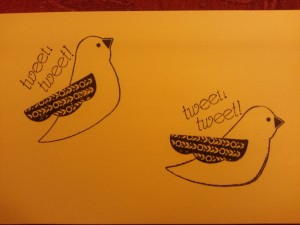Kagan Stuctures, the Music Wand, and Brain Breaks
Yesterday I subbed in an excellent school with third graders. I brought several of my usual bag of tricks for experimentation. Kagan structures for collaborative work (or breaks) and the music wand to gain attention continue to be hits with the students. I used a brain break during an hour long session of math worksheets. As I ran around a tiny table in front of table groups, a hit in itself, the students stood up to perform “the wave”. When first being introduced to brain breaks, I wondered if the interruption would serve as a hindrance to getting back into the groove of working. To date, this has not been my experience. Students love the change in routine, then continue working with a wonderful attitude. It deepens the teacher/student relationship which is interesting.
Many in this group had not heard of twitter, yet this didn’t stop the enjoyment of tweeting about personal events. If the students worked hard, they could tweet on a large post-it anything of interest. Here’s my header post-it:
Best result of using this method was learning more about each student. I visualize book responses, predictions, and inferring author’s intent in a very informal style which can still stimulate higher level thinking. A winner idea courtesy of Pinterest.
Class Dojo
Another experiment was the use of Class Dojo. Assuming I would not be using a computer in the classroom, I printed out a Class Dojo page with student roster numbers, table numbers, and one slot for “Whole Class”. Each slot has its own avatar in the appearance of a monster. I wish there were more monsters so each student could have an original image, but I believe I can create additional avatars if I choose. I’ll check into this later. I informed the students how I receive the best classes everytime I sub, but wanted a better way to brag to their teacher at the end of the day. Because of this, I printed out the avatar sheet. During the day, I would catch students performing three model behaviors: following directions, respecting people and property, and staying on task. There were no rewards from me, but I would leave the paper for the teacher so she could see how wonderfully her students behaved. Points, once earned, could not be taken away. This form of positive reinforcement was received very well for an initial trial. It will be interesting to see the effects over a longer term. I really have to thank my prior mentor during my internship for modelling true positive reinforcement. It was quite an experience to observe how effectively she managed the classroom without calling attention to any negative behavior.
Overall
At the end of the day, I would conclude all management experiments as successful. Three teachers asked for my name and number because the students responded well. This was a bonus since this is a school where I would love to be a part of the team – very positive, friendly, down to earth dynamics.

